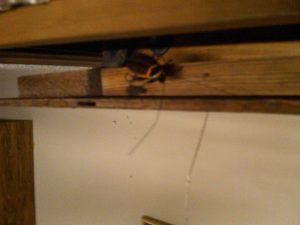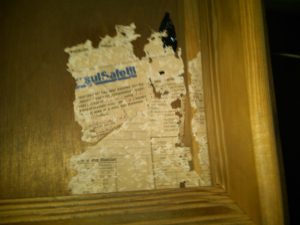No matter how you do it customers love having there attic treated. Fog machines or power dusters make a whirring sound and billow out a comforting cloud that calms the nerves of the customer who’s anxious about all those creepy creatures that live in the abyss whether imagined or real. Even if you just scramble up into the darkness armed with a bait shaker or aerosol, the mere fact you’ve treated this large virtually untouched area of the home brings relief and security for the homeowner whether you kill a million bugs or none at all.
There is one spot however that rarely gets any treatment even though you pass it by both going in and coming out. The access or entry rarely gets treated no matter the technique and it is this spot that I constantly see activity. How many times have you pushed back the attic door and seen a silverfish, roach or spider quickly scoot out of sight? Do you often find mouse or roach droppings over the cathedral ceiling as opposed to how many times this evidence is actually on or near the attic door itself?
Insects and rodents can and do live in the attic but remember they have certain needs (harborage, food & WATER) and it’s doubtful they’ll get it all up in the heat of the attic. With this in mind, where then would you think you might find the most congregations of these pests? They’re going to gravitate to areas that allow them to move freely between the protection of the attic and the bountiful fruits of the

Roach finding its way from attic
Treating the entry
There are many options for treating the entry area of any attic however there are just as many drawbacks. Treating 2×4’s with liquid residual sprays may work for the moment but the usually very dry wood just sucks up any liquid insecticide and nothing is left on the surface. Using a wettable powders, dusts or aerosols like Borid might last longer and stay on the contact area but the excessive heat will break it down faster than you think and residual powder on the exposed framework is often inadvertently touched by humans as they climb into the attic at a later date. (that’s not very good) To use these products you must make sure to put them on the backsides of the entry frame boards where touching is not likely or in the seams where 2×4’s are often ‘sistered’ up for strength. Attics are often floored for storage but the edges near the access expose the void created between the floor boards and ceiling drywall. This is a great spot for using powders or dusts and even heat resistant baits or sticky traps. For accesses with pull down ladders the same rules apply as far as exposed powders and dusts. Not only are the dusts in a place where human contact is probable, loose powders will fall down on you every time the

Silverfish damage to paper on pull down attic door
So while fogging the attic with big machines or traversing the trusses to treat the farthest reaches may be impressive to the customer and something you can proudly check off on your service ticket. Don’t be surprised if your client still has spiders, silverfish or occasional roaches. Especially if you forget to treat the entry.




